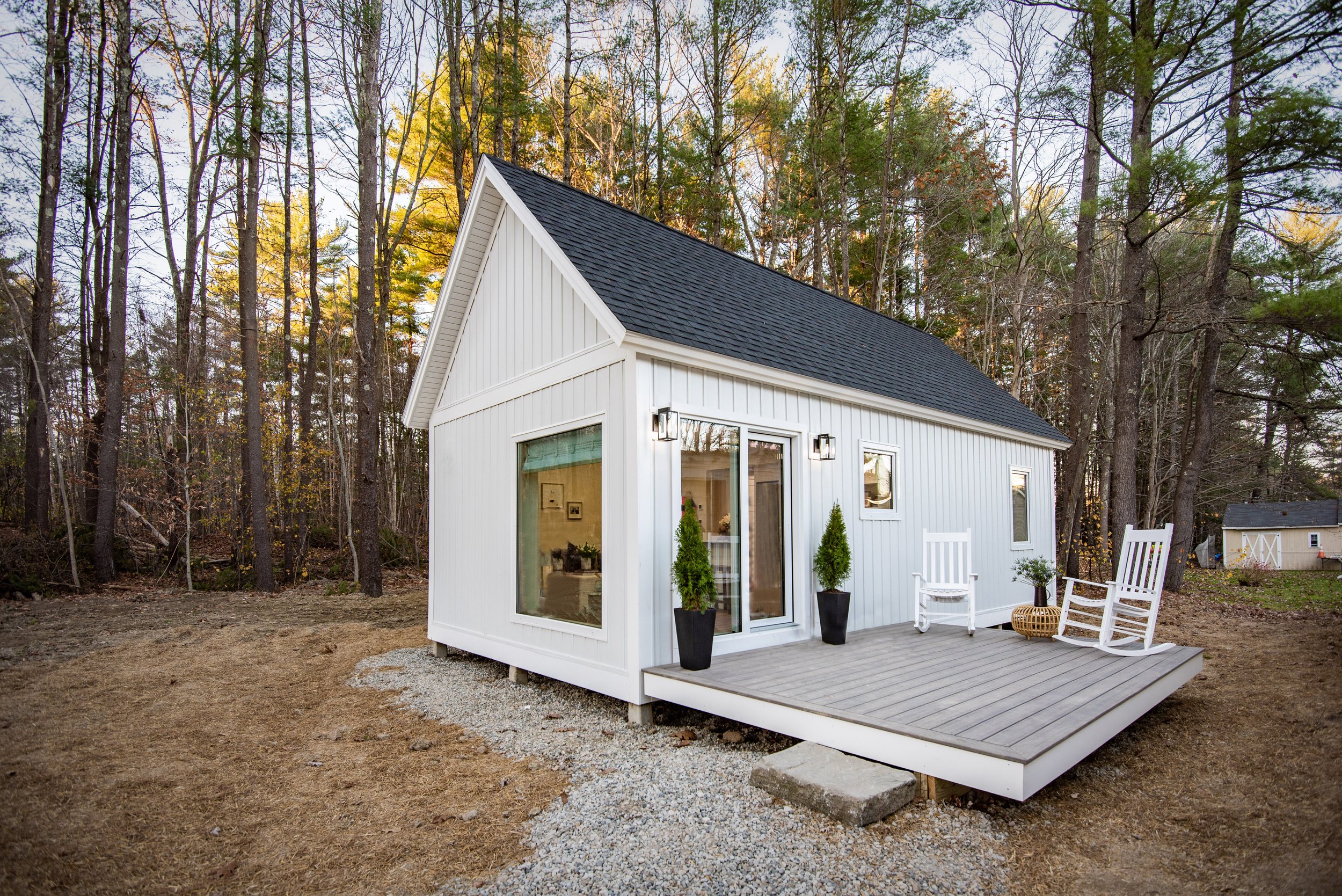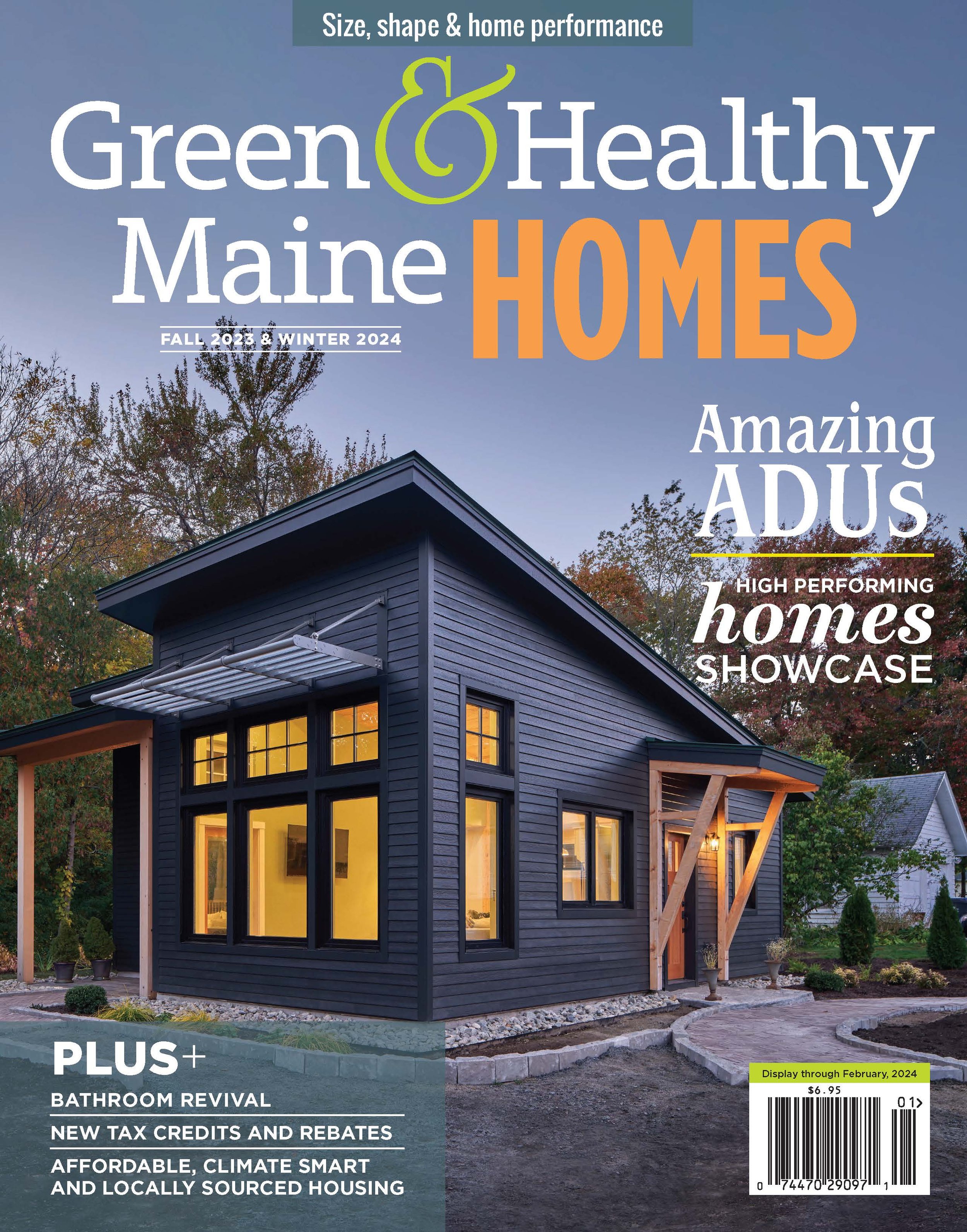South Portland's first detached ADU is a ground breaker
Pat Liddy envisioned this apartment for his mother where he used to have a rundown garage.
South portland couple transforms rundown garage into a modern accessory dwelling unit
By Amy Paradysz
Photos: Chris Battaglia unless otherwise noted
LOOKING AT THE RUNDOWN two-car garage behind their two-story beach bungalow on Lowell Street in South Portland, Pat Liddy and Stephanie Harmon saw potential. That location, they imagined, would be perfect for building an accessory dwelling unit (ADU) for Pat’s mother.
The trouble was that when they first hired design-builder O’Brien Wood & Iron, South Portland permitted only attached ADUs.
That left three options:
Build a 20-some-odd foot breezeway from the ADU to the primary house—a dealbreaker due to the expense and the way it would cut off access to the backyard.
File for a permit to build “bonus living space” and skip the kitchen—which had an obvious disadvantage.
Or start building the “bonus living space” while trusting that the City of South Portland would update the ADU code to allow detached structures and then apply for a change of use permit for an ADU.
“People from City Hall told us they were working on a code change because other people were interested,” Harmon said. “We had faith it was going to go in our favor.”
Thus began a yearlong project in which design and construction ran on a parallel track with city planning advocacy, with Pat Liddy and lead project designer Dave Ornvold meeting with city planners and attending city council meetings.
“ADUs are a great step towards solving the long-term rental housing shortage in cities like South Portland,” Ornvold said. “But it could quickly spin the other direction if they are turned into short-term rentals like Airbnbs. The city wanted to dot their i’s and cross their t’s to ensure the updated ordinance best serves the South Portland community and its residents.”
The city had taken its first pass at a detached ADU ordinance in early 2021. In October 2022—when Liddy and Harmon’s “bonus living space” was already under construction—the city approved a more permissive ordinance that eliminates the breezeway requirement for detached ADUs while prohibiting short-term rentals. Liddy and Harmon’s application for a change in use was accepted, the stove and refrigerator were ordered and installed, and the homeowners breathed a sigh of relief. Their detached ADU is the first to be completed in South Portland.
Pat Liddy with his mom Eileen Liddy and wife Stephanie Harmon. PHOTO: AMY PARADYSZ
Liddy and Harmon, avid paddle boarders, bought their 1930 two-story beach bungalow in 2019. Then 2020 was a devastating year for them, with Liddy losing his stepmother, then his father, and then Harmon her stepmother. That made them want to spend more time with her father, who lives relatively nearby in Arundel, and his mother, farther north in Farmington.
“We started thinking about how we could move her closer, spend more time with her and help her more with things,” Harmon says.
Across the yard, they had a two-car garage they didn’t use much. The slab foundation was slanted and some of the wood was rotten. But the location…what if they could turn it into a Passive House ADU?
While the Passive House high-efficiency building standard appealed to Liddy and Harmon, it didn’t make a lot of sense given the size of the project and their budget. They were looking for a company that would design something as green as possible—within their means.
“We asked for recommendations and O’Brien came up,” Liddy says.
O’Brien Wood & Iron is a Portland design-build firm that does residential and light commercial projects.
Some jobs are construction-only, when they work with other designers like Michael Maines (co-author of Pretty Good House: A Guide to Creating Better Homes). Some projects are design-only, ranging from retail to restaurant to new-construction homes. Liddy and Harmon’s ADU is a good example of O’Brien Wood & Iron’s full-service work.
Twelve years ago, art school graduate Mat O’Brien was restoring historic houses in Connecticut and doing ornamental architectural ironwork as O’Brien Wood & Iron. Then he moved his business to Maine in 2011. Joining the monthly building science discussion meetups at Performance Building Supply in Portland, he quickly became fascinated with high-efficiency construction.
“That was the Maine influence,” he says. “We do as much as we can with environmentally conscious design.”
O’Brien Wood & Iron has shifted away from ironwork—so much so that the forge is now used by Brant & Cochran, an ax-making company in South Portland. Meanwhile, O’Brien’s emphasis on wood has grown. Now O’Brien has both a cabinetmaking shop in Portland’s West End and a sister company called O’Brien Hardwoods on Presumpscot Street that caters to cabinet and furnituremakers.
Meanwhile, the O’Brien team has grown to 11 people, including two fulltime architectural designers.
Designer Dave Ornvold, who worked with Liddy and Harmon on their project, was able to get the location grandfathered by lifting the garage and pouring a new foundation on top of the old slanted one. The ADU, though more modern than the primary house, has a complementary aesthetic.
Designed by Studio Toer, the “Flock of Light” sculptural lighting element above the kitchen island provides comfortable task lighting without dominating the small space.
“The concept started as a modern surf shack and morphed into what we’re calling coastal modern design,” Ornvold says. The exterior has local white cedar siding with visible knots. To contrast with the white, Ornvold chose bronze-color window frames from Marvin’s Elevate line.
In terms of interior design, Liddy and Harmon wanted the ADU to be convenient for his 78-year-old mother, maximizing ease of movement and storage space. The bathroom, for example, has heated floors, a curb-free shower, a grab-bar and a 36-inch-wide door that can accommodate a walker or wheelchair, if necessary. The kitchen has lots of storage space, with upper and lower custom white oak cabinets, shelving inside the kitchen island and another cabinet in the living area. The washer and dryer are behind a sliding door in the bedroom beside Ikea armoires.
The back of the ADU has a vaulted ceiling with a large window to let in natural light.
Tiles by Heath Ceramics of San Francisco create eye-catching splashes of color and texture against the dark, polished concrete floors, white walls, with Tropics blue crackle in the shower and Pisces green in the kitchen.
But the star of the otherwise minimalist interior design is a chandelier called Flock of Light (designed by Studio Toer for Dutch design firm Moooi and purchased from Design Within Reach).
“We wanted something that would anchor the kitchen island/dining table but wouldn’t dominate and make the small space feel smaller,” Ornvold said. “This was the perfect solution. When on, the chandelier glows and sparkles in the space while also providing comfortable task lighting. When off, it is almost like it’s not there.”
Another key to the lightness in the ADU is the open-attic loft, which the homeowners envision using as a potential sleeping space later on. Present and possible future priorities created a design challenge: how to gain access to the loft without losing much of the 450 square feet of living space on the ground floor.
“Early on, we had designed a bookshelf/ladder to be built in the O’Brien shop,” Ornvold says. “But because using the loft for sleeping space isn’t a priority right now and maximizing storage is, that space was turned into a closet.”
Plan B is a rolling library ladder. Again, not a current priority.
The loft also created a bit of a debate about what is “sustainable.” While spray foam can be energy-efficient, its production is far from environmentally friendly. For that reason, O’Brien typically doesn’t use it. But here, they were working with existing garage rafters and creating an open-attic loft.
“We had to use spray foam to get the R value to meet code, because of the thickness of the roof line,” O’Brien says. “Otherwise, we would have had to deepen the roofline and it would have significantly shrunk the loft space.”
Measuring an R-value of 60 in the roof and 26 in the walls, the ADU will be efficient to heat and cool with a Mitsubishi Heat Pump 18000. A continuously run Panasonic WhisperGreen® exhaust fan provides ventilation with an air return in the millwork above the refrigerator.
“The original plan included a ducted heat system, but we recognized we could save the homeowner a good chunk of change if we went with a ceiling cassette for the heat pump,”
“ADUs are a great step towards solving the long term rental housing shortage in cities like South Portland. But it could quickly spin the other direction if they are turned into short-term rentals like Airbnbs. The City wanted to dot their i’s and cross their t’s to ensure the updated ordinance best serves the South Portland community and its residents.”
Ornvold says. “This did require some redesign on the partition between the bedroom and kitchen, which needed to remain open. We had to maintain clearance above the door to the bedroom to allow the heat pump to blow out into the main space.”
The privacy curtain, chosen rather than a sliding door for air-flow efficiency, adds an appealing softness to the space. The homeowners love the overall design.
“Dave [Ornvold] has such a good eye,” Harmon says. “And he really listens to what we want.”
The partnership is so successful that the homeowners are now working with O’Brien Wood & Iron on a redesign of the main house, which will get a significant facelift inside and out, as well as solar panels.
This article appeared in the Fall 2023 edition of Green & Healthy Maine HOMES. Subscribe today!
Find Maine experts that specialize in healthy, efficient homes in the Green Homes Business Directory.









